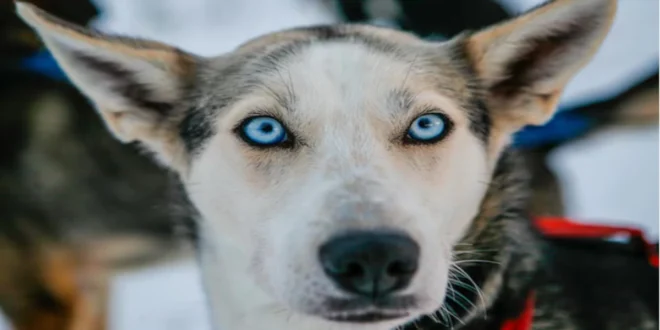What Dogs Have Blue Eyes? Discover Stunning Breeds
Blue eyes in dogs are a striking feature that immediately captures attention. Many dog lovers and potential dog owners wonder: What dogs have blue eyes? While blue eyes are often associated with certain breeds, they are not exclusive to one group. This article delves into the fascinating world of dogs with blue eyes, exploring the breeds that commonly exhibit this trait, the science behind blue eyes in dogs, and the potential health concerns associated with them.
Understanding Blue Eyes in Dogs: What Causes Them?
Before we dive into the breeds that are known for their blue eyes, it’s important to understand what causes this unique eye color. Blue eyes in dogs are a result of the way light interacts with the structure of the eye. The iris, the colored part of the eye, contains pigment called melanin. In dogs with blue eyes, there is less melanin, which allows more light to scatter and reflect off the eye, giving it a blue appearance.
Genetic Factors Behind Blue Eyes in Dogs
Genetics play a crucial role in determining eye color in dogs. Certain genes control the amount of melanin in the eye, and when these genes are expressed in particular ways, dogs may inherit blue eyes. In some cases, blue eyes may be the result of a recessive gene, which means both parents must carry the gene for a puppy to inherit it.
Additionally, some breeds are more predisposed to blue eyes due to their genetic makeup. However, blue eyes are not always tied to a specific breed, and occasionally, even dogs with no history of blue-eyed lineage may have blue eyes due to spontaneous mutations.
What Dogs Have Blue Eyes?
While blue eyes can appear in a variety of dog breeds, certain dogs are more likely to have them. Let’s take a look at some of the most popular breeds known for their striking blue-eyed appearance.
1. Siberian Husky: The Iconic Blue-Eyed Dog
The Siberian Husky is perhaps the most famous breed known for its striking blue eyes. Huskies are often portrayed in popular culture as having piercing blue eyes, though they can also have other eye colors, including brown, green, and even one eye of each color (known as heterochromia).
The blue eyes of a Siberian Husky are not just a cosmetic feature; they are also adapted to the cold, snowy environments these dogs were originally bred to work in. Their bright blue eyes are believed to help them see better in bright sunlight and snowstorms.
2. Australian Shepherd: A Dog with Expressive Eyes
Australian Shepherds, or Aussies, are another breed that frequently has blue eyes. Known for their intelligence and agility, these dogs often display a range of eye colors, from brown to amber to blue. Some Aussies even have one blue eye, a trait called heterochromia, where each eye is a different color.
Blue eyes in Australian Shepherds are particularly common among those with merle coat patterns. This genetic pattern can cause the dogs’ eyes to appear in varying shades of blue or even cause heterochromia.
3. Border Collie: Intelligence and Blue Eyes Combined
Border Collies are often regarded as one of the smartest dog breeds, and many of them have blue eyes. Like the Australian Shepherd, Border Collies with merle coats are particularly prone to having blue eyes. The blue-eyed Border Collie is both a beauty and a brain, excelling in herding tasks, agility competitions, and obedience trials.
4. Weimaraner: The Silver Dog with Stunning Eyes
Weimaraners are unique dogs with a silver-gray coat and captivating blue eyes. While they are not as commonly associated with blue eyes as some of the other breeds, Weimaraners can have striking blue eyes, particularly when they are young. As they mature, their eyes may change to a more amber or light green hue, but the blue-eyed look is one of the breed’s most mesmerizing features when they’re puppies.
5. Alaskan Malamute: A Larger Cousin to the Husky
Similar to the Siberian Husky, the Alaskan Malamute is a large breed known for its wolf-like appearance. While they are most commonly seen with brown eyes, there are cases of Malamutes born with blue eyes, especially in puppies. These dogs are known for their strength and endurance, and their blue eyes only add to their striking looks.
6. Catahoula Leopard Dog: A Rare Blue-Eyed Wonder
The Catahoula Leopard Dog is a rare and unique breed with a stunning coat pattern that can include spots and marbling. This breed is also known for its captivating blue eyes, which can sometimes appear in one or both eyes. Catahoulas are extremely versatile and often used as hunting dogs, herders, and even in search-and-rescue missions. Their blue eyes add to their intense and expressive look.
7. Great Dane: A Gentle Giant with Blue Eyes
Great Danes are enormous dogs with a calm, gentle nature. While their size can be intimidating, their blue eyes are anything but. Great Danes can occasionally have blue eyes, though it is not as common as in some of the other breeds listed. When they do have blue eyes, they tend to be one of the most striking features of these regal animals.
The Science of Blue Eyes in Dogs
While the blue eye color in dogs is largely a result of genetics, there is more to the science behind it. The lack of melanin in the iris, which gives dogs their blue eyes, is not just an aesthetic trait—it can also be a sign of certain health conditions.
Blue Eyes and Merle Coat Pattern
Many dogs with blue eyes, particularly those with merle coat patterns (such as Australian Shepherds, Border Collies, and Catahoulas), are more likely to experience certain health concerns. Merle dogs may have a higher risk of genetic conditions, including hearing loss and eye defects. The merle gene, while creating beautiful blue-eyed dogs, can also lead to issues like blindness or deafness in some cases, especially if the dog inherits two copies of the merle gene.
The Role of Albinism and Heterochromia
Some blue-eyed dogs may be born with albinism, which is characterized by a lack of pigment in the skin, eyes, and hair. Dogs with albinism often have blue or light-colored eyes, and these dogs are more prone to vision problems due to the absence of pigmentation in the eye.
Heterochromia, the condition where a dog has two different-colored eyes, can also lead to blue eyes. This condition is commonly seen in breeds such as Huskies, Border Collies, and Australian Shepherds. In some cases, one eye will be blue, while the other will be brown or amber, creating an eye-catching contrast.
Potential Health Concerns for Blue-Eyed Dogs
While blue eyes are a beautiful feature, they can sometimes be associated with specific health concerns, particularly in dogs with merle coat patterns or albinism. Some of the common issues include:
1. Vision Problems
Dogs with blue eyes may be more susceptible to certain vision problems, including sensitivity to light. Dogs with albinism may also experience a reduced ability to see in bright light due to the lack of pigmentation in the eye.
2. Hearing Loss
Certain breeds with blue eyes, especially those with merle coats, may have a higher risk of congenital deafness. This condition is more common in puppies that inherit two copies of the merle gene.
3. Eye Defects
Blue-eyed dogs, particularly those with merle coat patterns, may be at risk for eye defects such as cataracts or other vision impairments. Regular veterinary checkups are essential to ensure the health of their eyes and overall well-being.
Conclusion: Should You Choose a Blue-Eyed Dog?
Blue eyes in dogs are undeniably captivating, but it’s important to consider both the aesthetic and potential health implications when choosing a dog with this feature. If you are considering adopting a blue-eyed dog, be sure to choose a reputable breeder who screens for genetic conditions and provides health clearances. Regular veterinary care, including eye exams, is essential for ensuring the long-term health of your dog.
Whether you’re drawn to the striking appearance of a Siberian Husky, the intelligence of an Australian Shepherd, or the majestic look of a Great Dane, blue eyes can certainly make a dog even more unique. But remember, owning a dog is a long-term commitment, and it’s essential to prioritize the health and well-being of your pet above all else.
Frequently Asked Questions (FAQs)
Why do some dogs have blue eyes?
Blue eyes in dogs are the result of reduced melanin production in the iris. This lack of pigment allows light to scatter, giving the eyes their blue appearance. Some breeds are genetically predisposed to have blue eyes, while in other cases, blue eyes can occur due to genetic mutations or recessive genes.
Which dog breeds are most likely to have blue eyes?
Several dog breeds are known for their blue-eyed appearance. Some of the most common breeds include the Siberian Husky, Australian Shepherd, Border Collie, Weimaraner, and Alaskan Malamute. These breeds are often associated with blue eyes due to specific genetic traits, particularly the merle coat pattern in some cases.
Are dogs with blue eyes more prone to health issues?
Yes, dogs with blue eyes, especially those with merle coat patterns, can be more susceptible to certain health problems. These include vision issues like sensitivity to light, congenital deafness, and eye defects such as cataracts. Regular vet checkups are recommended to monitor their eye health and overall well-being.
Can a dog’s eye color change over time?
Yes, a dog’s eye color can change as it matures. For instance, puppies often have blue eyes that may transition to a darker color, such as amber, brown, or green, as they grow older. Some breeds, like the Weimaraner, are known to have blue eyes in their early stages, which may change as they age.
What is heterochromia in dogs?
Heterochromia is a condition where a dog has two different-colored eyes. This can result in one blue eye and one brown or green eye, which is commonly seen in breeds like Huskies and Border Collies. Heterochromia is usually a harmless condition, though it is important to monitor for any associated health concerns.
Is it common for dogs with blue eyes to have hearing loss?
While not all dogs with blue eyes experience hearing loss, certain breeds with merle coat patterns, such as the Australian Shepherd and Border Collie, are more likely to be born with congenital deafness. It is essential to have regular veterinary exams to check for any hearing impairments or other health concerns in dogs with blue eyes.
READ ALSO: Prior Lake MN Forecast: Your Ultimate Guide to Weather Patterns, Tips, and Local Insights
 Touch Blog
Touch Blog



